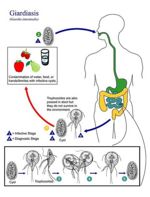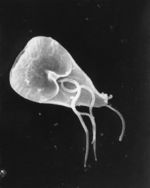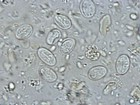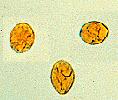Giardia
Jump to navigation
Jump to search
| Giardia | |
|---|---|
| Kingdom | Protista |
| Sub-kingdom | Biciliata |
| Phylum | Metamonada |
| Super-class | Eopharyngea |
| Class | Trepomonadea |
| Sub-class | Diplozoa |
| Order | Giardiida |
| Family | Diplomonadidae |
| Genus | Giardia |
Overview
These protozoan parasite are found in humans as well as wild and domestic animals. They are a common cause of severe diarrhoea as part of the clinical symptoms giardiasis.
Recognition
Giardia spp. are flagellate protozoa with 8 flagella, 6 of which emerge from the body and are used in motility. They are 15-20μm long, pear shaped with a flat ventral surface. The most unique feature of this protozoa is the presence of a large adhesive disk in the flat surface that is used for attaching to the intestinal mucosa.
Life Cycle
- Simple and direct
- Trophozoites attach to intestinal wall
- Reproduce by binary fission
- Form cysts of 10μm
- Multi-nucleate cysts formed intermittently
- Immediately infective when passed in faeces
- Prepatent period of 5-6 days
Pathogenesis
- Commonest cause of protozoal diarrhoea of man in the UK
- Common in domesticated animals
- Infections often asymptomatic in domestic animals
- Can cause villous atrophy leading to malabsorption
- Infection can persist for weeks to months if not treated
Epidemiology
- Infection via direct oral-faecal route or through contaminated water source (water-borne)
- Wild animals may act as a source of infection for humans
- E.g. Beavers
- Divided into 7 species
- G. duodenalis most commonly infects humans
- Some subspecies are zoonotic
- G. duodenalis most commonly infects humans
| Giardia Learning Resources | |
|---|---|
 Test your knowledge using flashcard type questions |
Giardia Flashcards |
| This article is still under construction. |



